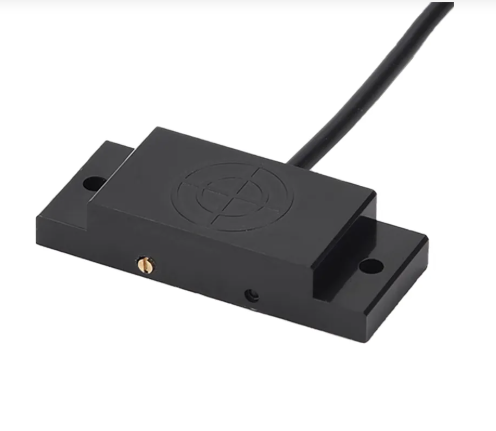Core Technologies Behind Proximity Switches
Eddy Current Sensing
Eddy current sensing is a pivotal technology in proximity switches, employing electromagnetic induction for non-contact detection of conductive materials, which significantly boosts durability and lifespan. This technology is especially valuable in industrial settings like automation and manufacturing, where conditions are often harsh. At its core, eddy current sensing works by generating an oscillating magnetic field that induces currents in nearby conductive metals, leading to detectable impedance changes that the sensor detects. According to empirical studies, eddy current sensors excel in providing high accuracy in measuring displacement and position, which is essential in precision engineering applications.
Kplus Technology for Universal Metal Detection
Kplus Technology signifies a leap forward in universal metal detection, extending its operational capabilities to non-ferrous metals. Traditional sensors primarily detect ferrous materials, but Kplus Technology overcomes this limitation, minimizing false positives and boosting reliability in complex industrial environments. By leveraging innovative algorithms, Kplus enhances sensitivity and reduces errors caused by environmental influences. Market analysis shows a growing demand for solutions utilizing Kplus technology in industries like food processing and pharmaceuticals, where precise metal detection is crucial for quality and safety.
Pulse Inductive and Magnetic Principles
Pulse inductive techniques rely on rapid magnetic field changes to detect objects, capitalizing on magnetic flux variations for detection. This method is advantageous for high-speed automation and robotics applications, as it offers faster response times compared to traditional proximity switches. Moreover, magnetic sensors enhance the versatility of proximity sensors by detecting various materials, making them applicable across different industries. Research highlights that pulse inductive devices not only maintain high detection reliability but also significantly reduce energy consumption, supporting sustainable industrial practices and aligning with green manufacturing goals.
Working Principle of Inductive Proximity Sensors
Electromagnetic Field Generation and Collapse
Inductive proximity sensors primarily function by creating an oscillating electromagnetic field surrounding the sensor’s surface, which detects changes when conductive materials enter this field. The creation of this field is a result of high-frequency oscillators. These oscillators can be sensitive to external factors, therefore requiring robust designs to ensure functionality. Research indicates that the frequency of oscillation directly affects the sensor's detection range and sensitivity; higher frequencies tend to offer shorter sensing distances. Furthermore, testing has shown that inductive sensors can capably operate with various shapes and sizes of targets, thus broadening their utility in diverse applications.
Role of Target Material in Sensing Range
The sensing range of inductive proximity sensors is significantly influenced by the material composition of the target object. Ferrous metals are more easily detected due to their magnetic properties compared to non-ferrous materials. As analytical data reveals, the return signal's strength diminishes with increased distance and is also influenced by the target's size and orientation. Understanding these material properties is essential for engineers to choose the optimal inductive proximity sensor suited to specific operational needs and constraints. Experts advocate accounting for environmental conditions and target properties during the design phase to optimize detection efficiency.
Signal Conversion and Output Logic
Inductive proximity sensors translate changes in electromagnetic fields into electrical signals, facilitating integration with control systems. This conversion is typically achieved via analog-to-digital converters (ADCs), which ensure compatibility with modern digital systems. Depending on the application and system compatibility, users can select different output logic formats, such as PNP, NPN, or analog. Studies highlight that choosing the right output logic is vital for maintaining signal integrity and enhancing system performance, especially in environments with high noise levels.
Key Components and Signal Processing
Housing Materials and Environmental Resistance
The housing of inductive proximity sensors is constructed from resilient materials such as plastic, stainless steel, or aluminum. These materials ensure durability against harsh environmental conditions often encountered in industrial settings. For instance, specific ratings like IP67 are used to indicate the level of protection a sensor offers against dust and water ingress—critical factors for applications in industries like petrochemicals, where temperatures can soar from desert heat to arctic cold. Research affirms that selecting suitable housing material significantly extends a sensor's lifespan, especially in corrosive environments or extreme temperature ranges. Additionally, ongoing advancements in housing technology aim to produce more compact sensor designs that are highly resistant to mechanical stress, improving the overall performance and reliability of the inductive proximity sensors.
Microprocessors and Analog-to-Digital Conversion
In modern inductive proximity sensors, microprocessors play an essential role in signal processing and precision control. These sophisticated components manage intricate algorithms designed to enhance sensitivity and minimize false detections. Through analog-to-digital conversion, which is a critical method within these sensors, seamless interaction with digital control systems occurs, enabling improved data analysis and strategic decision-making. Recent technological advancements have produced smarter sensors that not only consume less energy but also boast longer operational lifetimes. This continual development in microprocessor technology thus enhances the effectiveness and reliability of proximity sensors across different applications.
Calibration Techniques for Stable Operation
Calibration is vital for maintaining the accuracy of inductive proximity sensors over time, ensuring stable operation by adjusting outputs to compensate for drift and environmental fluctuations. Common techniques such as baseline adjustment and target-specific fine-tuning are crucial for applications requiring high precision. Research supports the assertion that regular calibration significantly reduces operational errors, enhancing the reliability of sensor-driven systems. Calibration intervals and methods, however, vary based on specific applications but remain integral for maintaining system performance and resilience. This procedural approach ensures that sensors consistently provide accurate readings, supporting optimal operation in diverse industrial environments.
Applications in Industrial and Automotive Systems
Machine Tool Positioning and Safety Systems
Inductive proximity sensors are critical in the automation of machine tools, allowing for precise positioning and real-time operation monitoring. By providing a non-contact method of detecting the presence of metal objects, these sensors minimize wear and tear on mechanical components, thereby enhancing longevity and operational efficiency. Studies show that the implementation of proximity sensors in safety systems can drastically reduce workplace accidents, ensuring that machinery is operated within safe parameters. Additionally, industries regularly analyze sensor performance metrics to optimize machine throughput, further minimizing downtime and improving productivity.
Automotive ABS and Electronic Stability Control
In the automotive sector, proximity switches are indispensable in Anti-lock Braking Systems (ABS) and electronic stability control, playing a pivotal role in vehicle safety. These sensors continuously monitor wheel speeds and rotational movements, providing real-time data that enables responsive braking and immediate stability corrections. According to various studies, cars equipped with advanced sensor technologies experience fewer accidents and improved handling dynamics. With the automotive market increasingly leaning towards automation and connectivity, the reliance on robust and precise proximity sensors for essential safety features is set to grow further.
Integration with Autonomous Vehicle Sensors
The integration of inductive proximity sensors in autonomous vehicles is essential for obstacle detection and navigation, key elements in ensuring operational safety. Their ability to operate reliably under different environmental conditions makes them well-suited for diverse terrains. Current research suggests that when these sensors are combined with other technologies like LiDAR and cameras, the overall perception and safety performance of vehicles are greatly enhanced. Real-world testing and simulations have demonstrated that autonomous vehicles equipped with comprehensive sensor arrays achieve higher safety ratings and operational efficiency, significantly advancing autonomous driving capabilities.
Advantages and Limitations of Proximity Switches
Non-Contact Operation and Long Service Life
One of the foremost advantages of proximity switches is their non-contact operation, significantly minimizing mechanical wear and maintenance needs. Unlike traditional switches that require direct contact, proximity switches rely on electromagnetic fields, ensuring less friction and longer-lasting components. Their solid-state designs contribute to extended service lives, often outperforming standard mechanical switches by several years. Empirical evidence highlights how non-contact operation boosts safety, particularly in environments with moving parts, which in turn reduces the risk of accidents. Industries are increasingly integrating these sensors, not only to cut operating costs but also to enhance reliability and efficiency over time.
Challenges with Small Targets and Environmental Interference
Despite numerous benefits, proximity switches encounter challenges with detecting small targets due to limitations in sensing range and sensitivity. These sensors may fall short in environments with fluctuating temperatures, dust, or electromagnetic interference, leading to unreliable outputs. Hence, stringent testing and maintenance procedures are essential to maintain sensor effectiveness, reaffirming the importance of material selection and installation practices. Insights from industry experts suggest that in complex environments, relying solely on proximity sensors may not be optimal, necessitating the integration of additional sensing technologies to ensure reliable performance.
Future Innovations in Sensing Range and Accuracy
The future of proximity switches is poised for significant advancements as new technologies promise to enhance sensing range and accuracy to meet growing industrial demands. Research into advanced materials and innovative sensing algorithms is paving the way for these sensors to overcome current limitations, including target detection and resilience against environmental impacts. Experts predict the integration of AI and machine learning will allow proximity sensors to adjust dynamically to varying conditions, thus improving reliability. Continued investment in research and development is likely to drive the adoption of next-generation proximity sensing systems, especially in automation, robotics, and automotive sectors.
FAQ
What is the main function of eddy current sensing in proximity switches?
Eddy current sensing employs electromagnetic induction to detect conductive materials non-contactly, enhancing durability and lifespan. It's widely used in harsh industrial settings like automation and manufacturing for high-accuracy displacement and position measurements.
How does Kplus Technology enhance metal detection?
Kplus Technology improves metal detection by extending capabilities to non-ferrous metals, minimizing false positives, and improving reliability in complex environments using innovative algorithms.
What role do microprocessors play in inductive proximity sensors?
Microprocessors manage signal processing and control intricate algorithms in inductive proximity sensors, enhancing sensitivity and minimizing false detections, while ensuring seamless interaction with digital control systems.
Why is calibration important for inductive proximity sensors?
Calibration is crucial for ensuring accurate sensor operation, compensating for drift and environmental fluctuations, and maintaining system performance and resilience over time.
What challenges do proximity switches face with small targets?
Proximity switches struggle with detecting small targets due to limitations in sensing range and sensitivity. Environmental factors like dust and electromagnetic interference also pose challenges to their reliability.
Table of Contents
- Core Technologies Behind Proximity Switches
- Working Principle of Inductive Proximity Sensors
- Key Components and Signal Processing
- Applications in Industrial and Automotive Systems
- Advantages and Limitations of Proximity Switches
-
FAQ
- What is the main function of eddy current sensing in proximity switches?
- How does Kplus Technology enhance metal detection?
- What role do microprocessors play in inductive proximity sensors?
- Why is calibration important for inductive proximity sensors?
- What challenges do proximity switches face with small targets?

